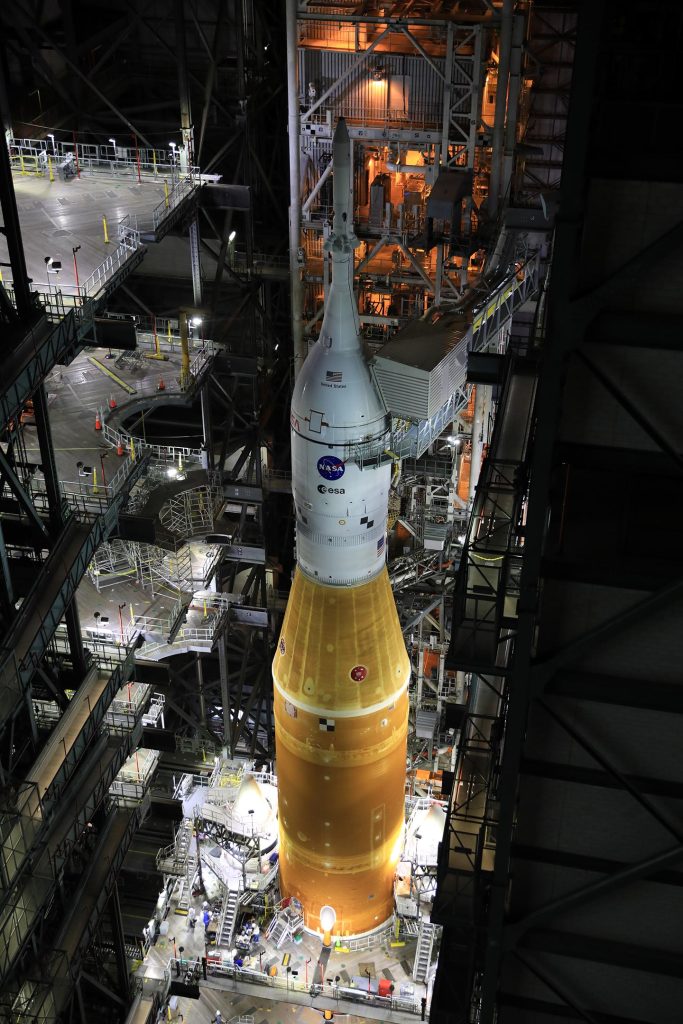Inżynierowie i technicy z NASA Kennedy Space Center na Florydzie 11 marca 2022 r. wjechali gąsienicą Carrier 2 pod drzwi budynku montażu pojazdów (VAB). Wkrótce dostaniesz się do VAB, gdzie przeniesiesz rakietę Artemis I Moon do Launch Pad 39B. Źródło: NASA/Czad Siwick
Wczoraj inżynierowie i technicy w[{” attribute=””>NASA’s Kennedy Space Center in Florida drove Crawler Transporter-2, which will carry NASA’s Moon rocket to the launch pad, to the doors of the Vehicle Assembly Building (VAB). Soon, the 6.6-million-pound crawler will go inside the VAB and slide under the Space Launch System rocket and Orion spacecraft placed on the Mobile Launcher. Technicians will finish up preparations to transport the rocket traveling at a top speed of 1 mph to Launch Complex 39B for a wet dress rehearsal test ahead of the Artemis I launch.
This week, the Kennedy team also completed painting the NASA worm logo on the Space Launch System solid rocket boosters. While painters added parts of the iconic logo before the segments were stacked, they had to wait until the boosters were fully assembled to finish the job.
Ponadto zespół kontynuował transport 20 platform otaczających rakietę Space Launch System i statek kosmiczny Orion, zanim wystawił je 17 marca do testów beta. Próba będzie ostatnim ważnym testem misji Artemis I i zapewni, że rakieta, statek kosmiczny, sprzęt naziemny i zespół startowy „śpią” przed startem.
Relacja, działania są zaplanowane na pierwszy start rakiety Mega Moon NASA
NASA zorganizuje telekonferencję w poniedziałek, 14 marca, aby omówić nadchodzące pojawienie się rakiety Mega Moon agencji i zintegrowanego statku kosmicznego dla bezzałogowej misji księżycowej Artemis I.

Wewnątrz budynku Vehicle Assembly Building w NASA Kennedy Space Center na Florydzie platformy robocze są holowane wokół rakiety Artemis I Space Launch System i statku kosmicznego Orion w ramach przygotowań do ich startu do testów. źródło: NASA
Rakieta Space Launch System Integrated i statek kosmiczny Orion mają wystrzelić wyrzutnię 39B w Kennedy Space Center na Florydzie w czwartek, 17 marca.
Rozmowa medialna rozpocznie się o 17:30 czasu wschodniego po zakończeniu przeglądu gotowości do testów, który określi, czy agencja jest gotowa do kontynuowania działań misyjnych. Rozmowa będzie transmitowana na żywo w agencji stronie internetowej.
Wśród uczestników telekonferencji:
- Tom Whitmer, zastępca dyrektora ds. rozwoju systemów eksploracji, siedziba NASA w Waszyngtonie
- Mike Sarafin, dyrektor misji Artemis, siedziba NASA
- Charlie Blackwell Thompson, Artemis Launch Manager, NASA Exploration Ground Systems Program, Kennedy
- John Honeycutt, kierownik programu kosmicznego startów kosmicznych, Marshall Space Flight Center w Huntsville, Alabama
- Howard Ho, dyrektor programu Orion, Johnson Space Center w Houston
Relacja na żywo z wprowadzenia rozpocznie się o godzinie 17:00 czasu wschodniego w czwartek, 17 marca i będzie zawierała notatki na żywo od administratora NASA Billa Nelsona i innych gości. Relacja będzie transmitowana NASA TVTen Aplikacja NASAA agencja stronie internetowej.
Na stoisku NASA przeprowadzi wcześniejszy test końcowy znany jako próba mokrego ubrania, który polega na wgraniu pliku[{” attribute=””>SLS propellant tanks and conducting a launch countdown.
The rollout involves a 4-mile journey between the Vehicle Assembly Building and the launch pad, expected to take between six and 12 hours. Live, static camera views of the debut and arrival at the pad will be available starting at 4 p.m. EDT on the Kennedy Newsroom YouTube channel.
Through Artemis missions, NASA will land the first woman and the first person of color on the Moon, paving the way for a long-term lunar presence and serving as a steppingstone on the way to Mars.

„Amatorski przedsiębiorca. Profesjonalny ekspert od internetu. Człowiek zombie. Nieuleczalny badacz popkultury”.
